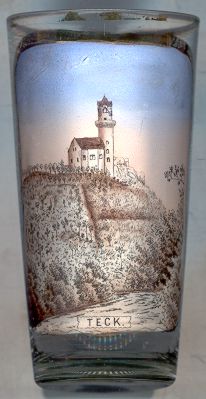

|
| DEUTSCHLAND | GERMANY |
| Bundesland: Baden-Württemberg | |
| Regierungsbezirk: Stuttgart | |
| Landkreis: Esslingen |
 Teck castle is situated on the Teck mountain (775 m) in the foothills of the Schwäbische Alb mountains.
The origins of the castle go back to the 12th century, when it was built by the Dukes of Zähringen. The oldest document
mentioning Teck castle is a contract of 1152 between Emperor Friedrich I (Barbarossa) and the Duke Berthold of Zähringen,
granting the latter the regnancy in Burgundy and Provence. Berthold's brother and successor, Adalbert, was the first who
in 1186/87 called himself Duke of Teck. The castle became the seat of a collateral line of the Zähringen family. Although the
main line became extinct in 1218, the Dukes of Teck were satisfied with a monetary compensation.
In the 14th century the castle came in possession of the Counts of Württemberg.
The last male member of the family, Ludwig of Teck, patriarch of Aquileia, died in 1439.
Since 1495 the counts of Württemberg also bore the title Dukes of Teck.
The castle was finally destroyed in 1525 during the Peasant' War. Two centuries later, in 1736, Duke Karl Alexander of Württemberg
began to convert the old castle into a major fortress, but the construction works were terminated prematurely when the duke
unexpecedly died in 1737. Restoration works began in 1864. During that time a lot of Romantic details were added, which were
removed again after World War II. The renovations were finally completed in 1955.
Teck castle is situated on the Teck mountain (775 m) in the foothills of the Schwäbische Alb mountains.
The origins of the castle go back to the 12th century, when it was built by the Dukes of Zähringen. The oldest document
mentioning Teck castle is a contract of 1152 between Emperor Friedrich I (Barbarossa) and the Duke Berthold of Zähringen,
granting the latter the regnancy in Burgundy and Provence. Berthold's brother and successor, Adalbert, was the first who
in 1186/87 called himself Duke of Teck. The castle became the seat of a collateral line of the Zähringen family. Although the
main line became extinct in 1218, the Dukes of Teck were satisfied with a monetary compensation.
In the 14th century the castle came in possession of the Counts of Württemberg.
The last male member of the family, Ludwig of Teck, patriarch of Aquileia, died in 1439.
Since 1495 the counts of Württemberg also bore the title Dukes of Teck.
The castle was finally destroyed in 1525 during the Peasant' War. Two centuries later, in 1736, Duke Karl Alexander of Württemberg
began to convert the old castle into a major fortress, but the construction works were terminated prematurely when the duke
unexpecedly died in 1737. Restoration works began in 1864. During that time a lot of Romantic details were added, which were
removed again after World War II. The renovations were finally completed in 1955.
The best-known figure from the family of the Dukes of Teck is probably Konrad II of Teck.
The regional tradition has it that after the death of the German King Rudolf I of Habsburg the Electors at first chose
Konrad as the new king. Konrad, however, is said to have been assassinated in the night of the 1st to 2nd of May 1292
on his way to Frankfurt, the place of the official election, where, on the 5th of May, Adolf of Nassau was
elected as successor of Rudolf I. The speculations about a possible election of Konrad of Teck are also based on the fact
that the coat of arms on Konrad's tomb in the church of Our Lady in Owen near Teck is ornated by an eagle's head and a crown
whereas the traditional coat of arms of the family only includes peacock feathers or a hound's head.
![[scale]](lineal.jpg)